Backstory
I've been using a Coolermaster ATC-201 case for about 8 years now. I'm a firm believer that if you buy a quality case you won't ever have to buy another again. I've been through 4 builds in this case alone, and I'm still not done with it.
So why am I buying a new case if this one is so great? I want another computer and I don't want to give up my current one. Typically when I build a new computer I buy a $20 case and dump my old components in it and gift it to a family member. Currently no family members are in need of a new computer and I want a server. Also, I'm running out of hard drive mount locations so a larger case would be nice.
Requirements
I had a few basic requirements for my new case. It must have plain sides (my only regret about my current case is the goofy grill on the side). The case must be all aluminum (I've really enjoyed how light my case is compared to similar sized steel cases, especially some of my old Dell machines). And finally it must not be the case equivalent of something like this:

The search
Looking at Newegg for what was in stock at the time, this small set of requirements pretty much instantly narrowed me down to Lian Li cases only. Some of the Silverstone cases looked nice, but the 90 degree motherboard rotation seems strange to me.
I ended up settling on the PC-B25S. There are several other Lian Li cases like this one, but the fact that it has usb 3.0 ports and promises to be a little quieter set it apart from the PC-B25F and others.
The PC-B25S arrives and I couldn't be more disappointed
I pull it out of the box, and it feels like a toy. Pushing on the top in different directions produces noticeable give and twisting in the case. Tapping on various parts causes metal on metal vibrations ring throughout the case, completely unlike my current ATC-201 which produces a dull thud.
Reviews like http://www.pureoverclock.com/review.php?id=1128&page=6 talk about the craftsmanship.
Finding a replacement
After some searching around I discovered Cooler Master actually makes a newer version of my current case. A bit hesitant because of the reviews complaining about thin side panels (really? after the tin foil Lian Li case, what might I be getting myself into?), I order it anyway. This time through Amazon to avoid making another $70 return policy mistake ( http://www.overclockers.com/forums/showthread.php?t=662528 ).
The Review
Cooler Master ATCS 840 and Lian Li PC-B25S compared to the older Cooler Master ATC-201
36 hours later the Cooler Master ATCS 840 is on my doorstep waiting when I get home from work.
First, an explanation of how this review is going to differ from the dozens you can already find through google. Most of the reviews out there already show you the pictures from the manufacture's website and maybe a few with components installed. They also talk about features, whether or not components are difficult to install, etc. What most reviews lack however is a discussion of material quality, fit, finish, and general sturdiness. This is where I will focus. Maybe some people don't care about quality of materials, but I certainly do. If I'm spending $200 on a case I want it to last a decade.
It may seem like I'm being overly harsh on these cases at points, but keep in mind I'm choosing to only talk about the build and materials. These cases have plenty of merits that are talked about in reviews elsewhere. Maybe it isn't fair to compare them to the ATC-201, maybe its overkill or maybe they just don't make cases like they used to. Whatever the case may be I like the solid feel.
Exterior
The obligatory outside shots. No my living room is not freakishly bright; the dark cases wouldn't show up without cranking up the brightness. My current case (ATC-201) is on the left along with some stickers and duct tape covering the led's which would otherwise keep me awake at night. The Lian Li is in the middle; notice the fingerprints, more on that in the next picture. The ATCS 840 is on the right and by far the largest (tall, wide, and long).


Here is a close-up of the side panels.

ATC-201 on top is a metallic grey paint with a clear coat topping. The interior of the panel does not have the clear coat. The paint job has held up extremely well over the past 8 years with no chips or real blemishes anywhere. You can see my coffee cup rings in the pictures above (they wipe right off), I definitely haven't been easy on this case, I use it like a table but it still looks good.
The Lian Li is in the middle, again notice the fingerprints. The Lian Li is a fingerprint magnet! The finish is smoother than the ATCS 840 which helps it attract fingerprints easier.
The ATCS 840 is on bottom. It’s the same color as the Lian Li, but the different angle and texture made it light up more in the camera flash. The texture is slightly rougher than the Lian Li (neither in a good nor bad way). I would be happy with either texture, but the rougher quality does help it avoid fingerprints.
Edge view of the side panels to show thickness of the material.

You'll have to forgive me if some shots are a bit blurry, the DOF at macro zooms is miniscule and hand holding both the camera and pieces in low light is not an easy task.
The ATCS 840 on the left looks thinner than the old ATC-201 on the right in this picture, but I had the impression they were equal in thickness. It could be from the 840 being out of focus. The Lian Li in the middle has the thickest side panels. This is the only place Lian Li excels, and in my opinion an area that does not matter as much. I have been happy with the side panels of the ATC-201 for all these years.
Drive Cage Quality
First up the ATC-201 at a healthy 1/16th of an inch. The cage is solid feeling under a prodding finger.


This shot of the drive cages is for later reference. Notice how they are essentially one solid sheet of aluminum with spots for screw holes.
Next up is the Lian Li, which appears to be half as thick.


On top of the material being half as thick, there is significantly less of it. The thin little bars of aluminum feel quite weak.
The ATCS 840 drive cage material appears to be the same thickness as the Lian Li, maybe slightly thicker.


The ATCS uses more material than the Lian Li, but still not as much as the ATC-201. In addition to more material the rolled edges of the cutouts are longer giving more stiffness. The end result is that the ATCS feels acceptably sturdy while the Lian Li feels like a toy. Neither matches the solid as a rock ATC-201.
Motherboard Tray Quality

On the right you see my motherboard still mounted to the ATC-201, in the center you can see the edges of the ATC-201 and ATCS 840 up against each other. Huge difference in thickness of material. The Lian Li motherboard tray is not removable, so I couldn't really get an edge shot of it, but you can use the pictures below of the screw holes to judge its thickness.
Here is the backside of the ATC-201 showing how sturdy the motherboard mount locations are. They are steel nuts sunk into the aluminum; the other place I've seen this technique used is on my Jeep where a Grade 8 nut will be welded onto the frame giving you a much stronger mount point that is virtually impossible to strip the threads out of.


Above is a picture with a screw in it showing the thickness of the combined motherboard tray and nut.
Here is a mount location on the ATCS 840. Notice how clean it is for when we compare it to the Lian Li.


A shot with a screw installed.
Lian Li mounts. Unlike the Cooler Master mounts which were all uniform, they Lian Li mounts are all different, sloppy, and rough. This was one of the worse examples, on the top side of the screw hole there are only one or two threads for the screw to catch.


Lian Li with a screw installed. The screw is sticking out further suggesting thinner material than the ATCS 840.
More Screw Mounts
Here is another shot of one of the ATC-201 screw holes. This one happens to be on the back of the case to hold the side panels on; the integrated nut technique is used for every screw hole through the whole case (or at least as far as I can tell).

I did find one place sturdy mount locations were used on the ATCS 840. This is the back of the hard drive cage. I'm not sure what these are for?

Bottom of the Case
The Lian Li did use "strong" mount locations similar to what I described above in one location: to hold the feet on the case. As we'll see in a moment though Lian Li’s method of mounting the feet still doesn't come close to Cooler Master cases.

Here is how the feet are attached on the ATCS 840. There is a solid bar connecting both of the front feet acting as a solid screw mount and giving rigidity to the case. (There is also a bar connecting the two rear feet)

The ATC-201 again blows both of the newer cases away. The entire bottom of the case is the thickness of the ATCS 840's reinforcing bar at a minimum. On top of being one solid sheet of aluminum it has two sections which are twice as thick running front to back the length of the case. On top of those two double thickness sections one side has another vertical piece adding even more reinforcement. All of this is milled out of one solid piece of aluminum. You could beat on the bottom of this case with a hammer and not hurt it. Here's a cross section picture followed by a picture showing the thicker section runs the length of the case front to back.


Power Supply Air Intake
The old ATC-201 has its power supply in the normal ATX specified location at the top of the case so there is nothing to see for it, other than the picture above which shows there is no air intake on the bottom rear of the case.
The ATCS 840 is shown here. There are several things worth pointing out in this picture.
1) The removable dust filter which other reviews will talk about.
2) The end of the reinforcing bar going between the two rear feet, which I mentioned above.
3) Notice the lower side rail is made of the same material the drive cage is made out of, also notice the “L” shape for later comparison to the Lian Li.
4) Notice how open the honeycomb cut is for later comparison.

The Lian Li is shown here. Things worth pointing out:
1) The dust filter is on the underside of the case.
2) Again the same foot mounting as the front of the case, which was already shown.
3) Like the Cooler Master cases, the lower side rail is made of the same material as the drive cage (Recall that the ATC-201 material was double the thickness of the ATCS 840 which was the same or negligibly thicker than the Lian Li). Notice that Lian Li just folds the material over rather than using an “L” type of construction. The “L” construction on the ATCS 840 makes it more resistant to horizontal twisting. Also note the Lian Li has a number of cuts and cutouts further weakening these rails while both Cooler Master cases use solid material.
4) The bottom of the Lian Li cases has much less area for air flow. I’m guessing they sacrificed air flow to keep more material in this area to prevent the case from breaking due to the weak side rails.

Back Panel
Not much to say here, the back panel on each case is made of the same material as the drive cage, which has already been shown. The back panel is also impossible to photograph; here is a terrible shot holding the ATC-201 up to the ATCS 840. In this blurry slightly off angle shot the ATC-201 only appears 50% thicker, while in the more clear drive cage shots with the tape measure we know it to be twice the thickness.

The very top of the ATCS 840 does have a section that is 1/16th of an inch like the whole of the ATC-201. This section is removable along with the top grill so you can get to the fans.

Front and Top Panel Materials
There isn’t much to say about the Lian Li here; it uses the same thin (in the neighborhood of 1/32”) material as the rest of the case.
Thickest material in any location on all 3 cases is used on top of the ATCS 840. It covers the front third of the case and has the cutouts for the buttons and usb/audio/e-sata popup panel.

The top corner rails and other reinforcements on the top of the ATCS 840 appears to be just shy of 1/8th of an inch thick material. This is quite sturdy combined with the 5/16th slab already shown. The ATCS 840 actually beats the ATC-201 in thickness of material here, which allows it to have the two 230mm fans without any rigidity concerns. The much older ATC-201 only has a single 60mm fan. It’s a shame the ATCS 840 didn’t use thick material like this for the bottom rails also like the older ATC-201.
The front fan cover is as thick as the top pictured above at its thickest part and probably more like 1/8th” thick in the rest; it’s hard to measure because its curved. Likewise the whole front is curved and hard to measure without taking the case apart. The front is incredibly sturdy, I’m quite comfortable sitting on it, and it feels solid as a rock.
I’ve already talked about the ATC-201 in comparison to the ATCS 840, so here is a picture of the front of the ATC-201.

Again, not much to say or show about the Lian Li, I’ve already shown a measurement of its drive cage material. The front is made out of the same stuff. You can check Lian Li’s website or other reviews to show how the front face pops off. I guess the only thing I could say is I would definitely not be comfortable sitting on the case for fear of it collapsing under me and with even light pressure the case gives and twists.
Manufacturing Tolerances
Now that you’ve got a good feel for what kind of materials the cases are made out of let’s talk about how well they are put together. All three cases seem to be put together extremely well. What I’ll be showing here are really just nitpicks and some design choices.
This picture shows how tight the front 5.25” drive blanks fit together on the ATCS 840. All of the spaces are uniform and tight like this.

Here is the ATC-201. From these close up pictures it appears not as tight, but it’s just because the aluminum used in the ATC-201 is much thicker so there is more of a roll to the edge exaggerates this distance. In person the panels look just as nice fitting as the ATCS 840, since you can tell the material is thicker.

Here is the top of the top panel of the Lian Li. Unlike the ATC-201 which had the aluminum meet as it rolls inward, this is actually a small but noticeable gap above the top panel between the surrounding face of the case. The lower panels have no gaps between them just like the ATCS 840, so if you are installing a dvd/bluray drive it may not be an issue. Personally I’ve gone driveless recently.

Here is the side panel of the ATC-201.

Here is the Lian Li. The corner piece is plastic held on by the screws. The flash helps it look somewhat the same, but in person the difference in material is more noticeable. One thing to point out is unlike the Cooler Master cases which have a side and a top, the Lian Li has a side, middle, and top so there are two seams instead of one. One complaint I have about this case is the lower seam is not uniform from front to back of the case, they should have either rolled the edge under the whole way or left it strait the whole way, the transition draws attention to it at which point you notice the gap between the side panel and the middle strip. The gap isn’t really a manufacturing tolerance problem but rather a design issue, because the middle strip isn’t rolled under all the way to the front of the case, the side panel can’t get any higher up. The silver shining through toward the front of the case can’t really be seen in normal lighting without the camera flash.

ATCS 840 side panel top corner. The silver shining through toward the front of the case can’t really be seen in normal lighting without the camera flash.

A final nitpick about the Lian Li: they should have done a better job with the top of the case. It feels unfinished with the plastic end cap screwed on the front and the back being aluminum sloppily bent into shape and not even attached together.

Miscellaneous
The screws used by Cooler Master haven’t changed a bit in the past 8 years. The left two screws are the ATC-201 and ATCS 840, the right is Lian Li. It feels like the Cooler Master screws are a heavier material, maybe just because they are larger. The larger diameter and longer grooved surface makes them easier to grip.


The design of the ATC-201 allows you to remove the motherboard tray without removing either side. The ATCS 840 not shown here, covers the motherboard tray with the back of the side panels. Obviously you will usually be removing the “normal” side, but it shouldn’t be necessary to remove the side behind the motherboard tray unless you want to. The Lian Li does not have a removable motherboard tray.

Conclusions
Neither of the cases I was looking at to replace the ATC-201 come close to matching its sturdy construction. The ATCS 840 has a solid construction for the front and top of the case. There is nothing wrong with the rest of the ATCS; I just wouldn’t be comfortable jumping up and down on it like I would be with the ATC-201. The Lian Li on the other hand just didn’t meet my expectations. I guess I’m glad I had the Lian Li to compare the ATCS against, otherwise I wouldn’t have a benchmark for how thin materials can be.
They just don’t seem to make cases like they used to. Maybe my sample size of 3 cases isn’t big enough to really draw any conclusions, but the fact that it doesn’t seem like many review sites (at least that I could find) complain about thinness of material was somewhat surprising. I wouldn’t mind if reviews started including that kind of information on top of just talking about sound, airflow, and how well components fit. I mean those are all important, but so are quality of materials and build quality. On that note, it is important to point out that the ATCS and Lian Li have a lot of merits which can be read about elsewhere, I just chose to focus my attention on the build and materials.
This post might read like I am biased against the Lian Li. I might agree with that assessment, it is my least favorite of the three cases. But remember that I did not start out with this bias. I originally bought the case based on my impressions of Lian Li’s reputation and after a lot of consideration. I was really looking forward to the Lian Li, but once I got it in my hands the quality disappointed. I wanted to like the Lian Li, I really did. I even kicked around the idea of keeping it after I found out how expensive it would be to return, but couldn’t bring myself to do it. Despite a somewhat biased tone, hopefully if you are considering the Lian Li PC-B25S or Cooler Master ATCS 840 the pictures and descriptions of materials will be useful to you in conjunction with other typical reviews you’ll find of these cases.
I've been using a Coolermaster ATC-201 case for about 8 years now. I'm a firm believer that if you buy a quality case you won't ever have to buy another again. I've been through 4 builds in this case alone, and I'm still not done with it.
So why am I buying a new case if this one is so great? I want another computer and I don't want to give up my current one. Typically when I build a new computer I buy a $20 case and dump my old components in it and gift it to a family member. Currently no family members are in need of a new computer and I want a server. Also, I'm running out of hard drive mount locations so a larger case would be nice.
Requirements
I had a few basic requirements for my new case. It must have plain sides (my only regret about my current case is the goofy grill on the side). The case must be all aluminum (I've really enjoyed how light my case is compared to similar sized steel cases, especially some of my old Dell machines). And finally it must not be the case equivalent of something like this:

The search
Looking at Newegg for what was in stock at the time, this small set of requirements pretty much instantly narrowed me down to Lian Li cases only. Some of the Silverstone cases looked nice, but the 90 degree motherboard rotation seems strange to me.
I ended up settling on the PC-B25S. There are several other Lian Li cases like this one, but the fact that it has usb 3.0 ports and promises to be a little quieter set it apart from the PC-B25F and others.
The PC-B25S arrives and I couldn't be more disappointed
I pull it out of the box, and it feels like a toy. Pushing on the top in different directions produces noticeable give and twisting in the case. Tapping on various parts causes metal on metal vibrations ring throughout the case, completely unlike my current ATC-201 which produces a dull thud.
Reviews like http://www.pureoverclock.com/review.php?id=1128&page=6 talk about the craftsmanship.
The PC-B25S offers us the build quality that Lian Li is deservingly known for.
While I have to agree most the pieces seem to fit well, they seem to be made of tin foil and paper. The quality of the materials just is not what I’m used to or what I expected, and in fact there are a few places that don't fit together well which I'll get to later.everything fits together like a beautiful puzzle
Finding a replacement
After some searching around I discovered Cooler Master actually makes a newer version of my current case. A bit hesitant because of the reviews complaining about thin side panels (really? after the tin foil Lian Li case, what might I be getting myself into?), I order it anyway. This time through Amazon to avoid making another $70 return policy mistake ( http://www.overclockers.com/forums/showthread.php?t=662528 ).
The Review
Cooler Master ATCS 840 and Lian Li PC-B25S compared to the older Cooler Master ATC-201
36 hours later the Cooler Master ATCS 840 is on my doorstep waiting when I get home from work.
First, an explanation of how this review is going to differ from the dozens you can already find through google. Most of the reviews out there already show you the pictures from the manufacture's website and maybe a few with components installed. They also talk about features, whether or not components are difficult to install, etc. What most reviews lack however is a discussion of material quality, fit, finish, and general sturdiness. This is where I will focus. Maybe some people don't care about quality of materials, but I certainly do. If I'm spending $200 on a case I want it to last a decade.
It may seem like I'm being overly harsh on these cases at points, but keep in mind I'm choosing to only talk about the build and materials. These cases have plenty of merits that are talked about in reviews elsewhere. Maybe it isn't fair to compare them to the ATC-201, maybe its overkill or maybe they just don't make cases like they used to. Whatever the case may be I like the solid feel.
Exterior
The obligatory outside shots. No my living room is not freakishly bright; the dark cases wouldn't show up without cranking up the brightness. My current case (ATC-201) is on the left along with some stickers and duct tape covering the led's which would otherwise keep me awake at night. The Lian Li is in the middle; notice the fingerprints, more on that in the next picture. The ATCS 840 is on the right and by far the largest (tall, wide, and long).
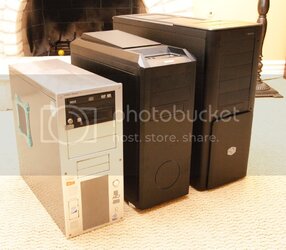
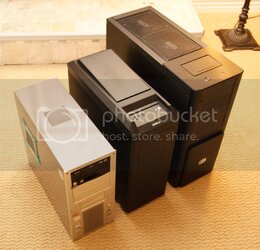
Here is a close-up of the side panels.

ATC-201 on top is a metallic grey paint with a clear coat topping. The interior of the panel does not have the clear coat. The paint job has held up extremely well over the past 8 years with no chips or real blemishes anywhere. You can see my coffee cup rings in the pictures above (they wipe right off), I definitely haven't been easy on this case, I use it like a table but it still looks good.
The Lian Li is in the middle, again notice the fingerprints. The Lian Li is a fingerprint magnet! The finish is smoother than the ATCS 840 which helps it attract fingerprints easier.
The ATCS 840 is on bottom. It’s the same color as the Lian Li, but the different angle and texture made it light up more in the camera flash. The texture is slightly rougher than the Lian Li (neither in a good nor bad way). I would be happy with either texture, but the rougher quality does help it avoid fingerprints.
Edge view of the side panels to show thickness of the material.

You'll have to forgive me if some shots are a bit blurry, the DOF at macro zooms is miniscule and hand holding both the camera and pieces in low light is not an easy task.
The ATCS 840 on the left looks thinner than the old ATC-201 on the right in this picture, but I had the impression they were equal in thickness. It could be from the 840 being out of focus. The Lian Li in the middle has the thickest side panels. This is the only place Lian Li excels, and in my opinion an area that does not matter as much. I have been happy with the side panels of the ATC-201 for all these years.
Drive Cage Quality
First up the ATC-201 at a healthy 1/16th of an inch. The cage is solid feeling under a prodding finger.
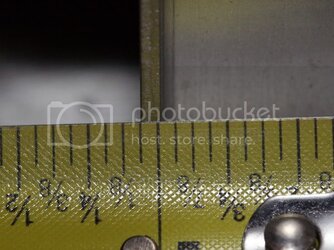

This shot of the drive cages is for later reference. Notice how they are essentially one solid sheet of aluminum with spots for screw holes.
Next up is the Lian Li, which appears to be half as thick.
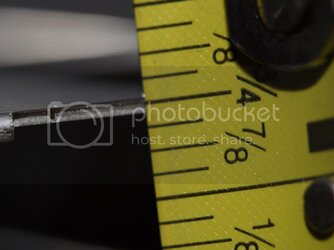

On top of the material being half as thick, there is significantly less of it. The thin little bars of aluminum feel quite weak.
The ATCS 840 drive cage material appears to be the same thickness as the Lian Li, maybe slightly thicker.
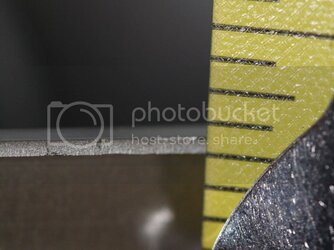
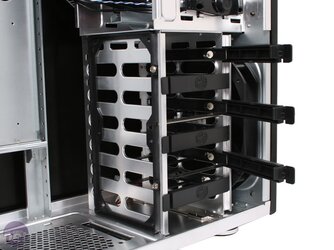
The ATCS uses more material than the Lian Li, but still not as much as the ATC-201. In addition to more material the rolled edges of the cutouts are longer giving more stiffness. The end result is that the ATCS feels acceptably sturdy while the Lian Li feels like a toy. Neither matches the solid as a rock ATC-201.
Motherboard Tray Quality
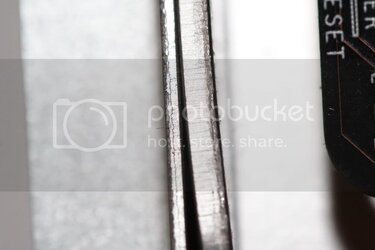
On the right you see my motherboard still mounted to the ATC-201, in the center you can see the edges of the ATC-201 and ATCS 840 up against each other. Huge difference in thickness of material. The Lian Li motherboard tray is not removable, so I couldn't really get an edge shot of it, but you can use the pictures below of the screw holes to judge its thickness.
Here is the backside of the ATC-201 showing how sturdy the motherboard mount locations are. They are steel nuts sunk into the aluminum; the other place I've seen this technique used is on my Jeep where a Grade 8 nut will be welded onto the frame giving you a much stronger mount point that is virtually impossible to strip the threads out of.
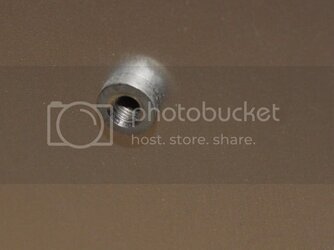
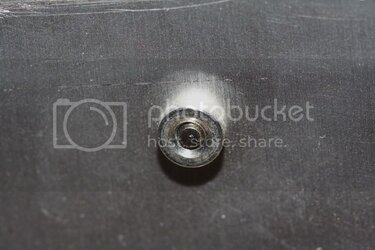
Above is a picture with a screw in it showing the thickness of the combined motherboard tray and nut.
Here is a mount location on the ATCS 840. Notice how clean it is for when we compare it to the Lian Li.
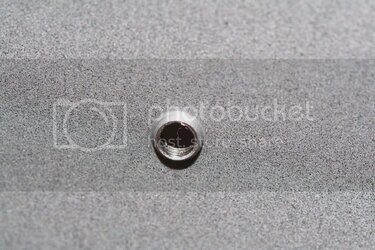
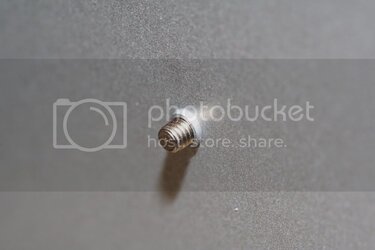
A shot with a screw installed.
Lian Li mounts. Unlike the Cooler Master mounts which were all uniform, they Lian Li mounts are all different, sloppy, and rough. This was one of the worse examples, on the top side of the screw hole there are only one or two threads for the screw to catch.
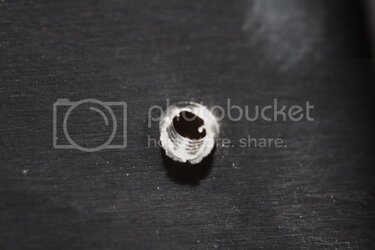
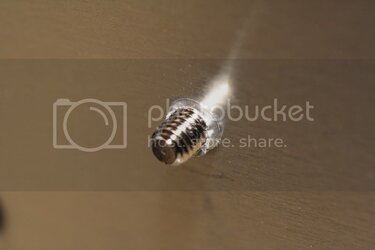
Lian Li with a screw installed. The screw is sticking out further suggesting thinner material than the ATCS 840.
More Screw Mounts
Here is another shot of one of the ATC-201 screw holes. This one happens to be on the back of the case to hold the side panels on; the integrated nut technique is used for every screw hole through the whole case (or at least as far as I can tell).
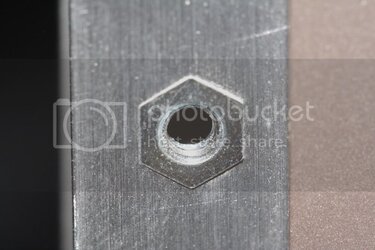
I did find one place sturdy mount locations were used on the ATCS 840. This is the back of the hard drive cage. I'm not sure what these are for?
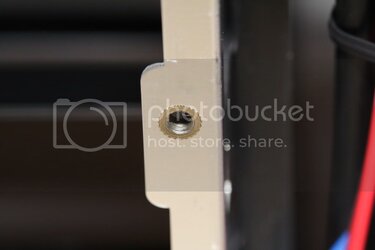
Bottom of the Case
The Lian Li did use "strong" mount locations similar to what I described above in one location: to hold the feet on the case. As we'll see in a moment though Lian Li’s method of mounting the feet still doesn't come close to Cooler Master cases.
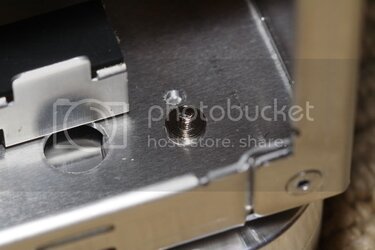
Here is how the feet are attached on the ATCS 840. There is a solid bar connecting both of the front feet acting as a solid screw mount and giving rigidity to the case. (There is also a bar connecting the two rear feet)
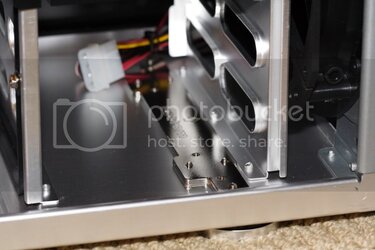
The ATC-201 again blows both of the newer cases away. The entire bottom of the case is the thickness of the ATCS 840's reinforcing bar at a minimum. On top of being one solid sheet of aluminum it has two sections which are twice as thick running front to back the length of the case. On top of those two double thickness sections one side has another vertical piece adding even more reinforcement. All of this is milled out of one solid piece of aluminum. You could beat on the bottom of this case with a hammer and not hurt it. Here's a cross section picture followed by a picture showing the thicker section runs the length of the case front to back.
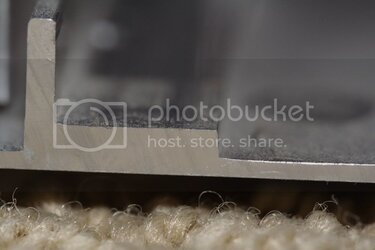
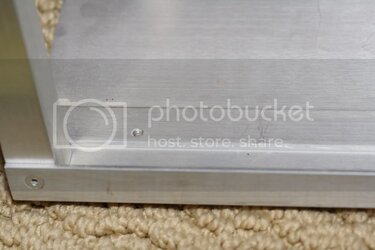
Power Supply Air Intake
The old ATC-201 has its power supply in the normal ATX specified location at the top of the case so there is nothing to see for it, other than the picture above which shows there is no air intake on the bottom rear of the case.
The ATCS 840 is shown here. There are several things worth pointing out in this picture.
1) The removable dust filter which other reviews will talk about.
2) The end of the reinforcing bar going between the two rear feet, which I mentioned above.
3) Notice the lower side rail is made of the same material the drive cage is made out of, also notice the “L” shape for later comparison to the Lian Li.
4) Notice how open the honeycomb cut is for later comparison.
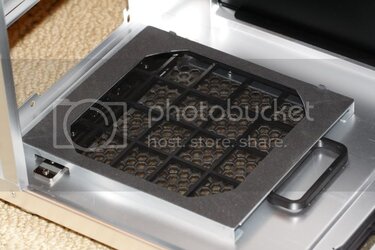
The Lian Li is shown here. Things worth pointing out:
1) The dust filter is on the underside of the case.
2) Again the same foot mounting as the front of the case, which was already shown.
3) Like the Cooler Master cases, the lower side rail is made of the same material as the drive cage (Recall that the ATC-201 material was double the thickness of the ATCS 840 which was the same or negligibly thicker than the Lian Li). Notice that Lian Li just folds the material over rather than using an “L” type of construction. The “L” construction on the ATCS 840 makes it more resistant to horizontal twisting. Also note the Lian Li has a number of cuts and cutouts further weakening these rails while both Cooler Master cases use solid material.
4) The bottom of the Lian Li cases has much less area for air flow. I’m guessing they sacrificed air flow to keep more material in this area to prevent the case from breaking due to the weak side rails.
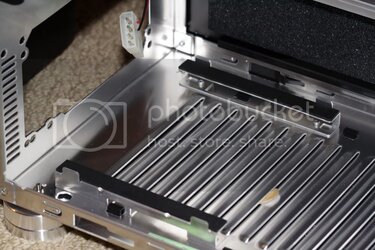
Back Panel
Not much to say here, the back panel on each case is made of the same material as the drive cage, which has already been shown. The back panel is also impossible to photograph; here is a terrible shot holding the ATC-201 up to the ATCS 840. In this blurry slightly off angle shot the ATC-201 only appears 50% thicker, while in the more clear drive cage shots with the tape measure we know it to be twice the thickness.

The very top of the ATCS 840 does have a section that is 1/16th of an inch like the whole of the ATC-201. This section is removable along with the top grill so you can get to the fans.
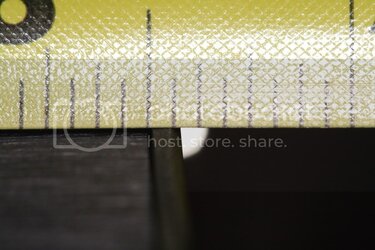
Front and Top Panel Materials
There isn’t much to say about the Lian Li here; it uses the same thin (in the neighborhood of 1/32”) material as the rest of the case.
Thickest material in any location on all 3 cases is used on top of the ATCS 840. It covers the front third of the case and has the cutouts for the buttons and usb/audio/e-sata popup panel.
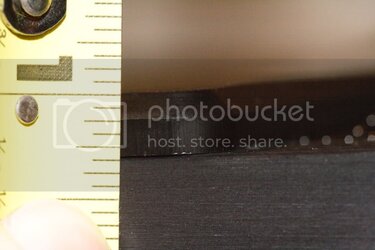
The top corner rails and other reinforcements on the top of the ATCS 840 appears to be just shy of 1/8th of an inch thick material. This is quite sturdy combined with the 5/16th slab already shown. The ATCS 840 actually beats the ATC-201 in thickness of material here, which allows it to have the two 230mm fans without any rigidity concerns. The much older ATC-201 only has a single 60mm fan. It’s a shame the ATCS 840 didn’t use thick material like this for the bottom rails also like the older ATC-201.
The front fan cover is as thick as the top pictured above at its thickest part and probably more like 1/8th” thick in the rest; it’s hard to measure because its curved. Likewise the whole front is curved and hard to measure without taking the case apart. The front is incredibly sturdy, I’m quite comfortable sitting on it, and it feels solid as a rock.
I’ve already talked about the ATC-201 in comparison to the ATCS 840, so here is a picture of the front of the ATC-201.

Again, not much to say or show about the Lian Li, I’ve already shown a measurement of its drive cage material. The front is made out of the same stuff. You can check Lian Li’s website or other reviews to show how the front face pops off. I guess the only thing I could say is I would definitely not be comfortable sitting on the case for fear of it collapsing under me and with even light pressure the case gives and twists.
Manufacturing Tolerances
Now that you’ve got a good feel for what kind of materials the cases are made out of let’s talk about how well they are put together. All three cases seem to be put together extremely well. What I’ll be showing here are really just nitpicks and some design choices.
This picture shows how tight the front 5.25” drive blanks fit together on the ATCS 840. All of the spaces are uniform and tight like this.
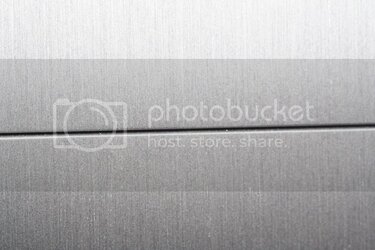
Here is the ATC-201. From these close up pictures it appears not as tight, but it’s just because the aluminum used in the ATC-201 is much thicker so there is more of a roll to the edge exaggerates this distance. In person the panels look just as nice fitting as the ATCS 840, since you can tell the material is thicker.
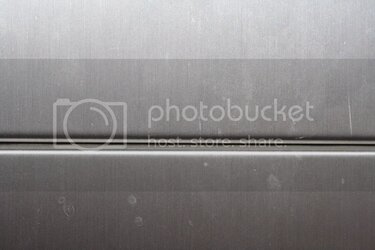
Here is the top of the top panel of the Lian Li. Unlike the ATC-201 which had the aluminum meet as it rolls inward, this is actually a small but noticeable gap above the top panel between the surrounding face of the case. The lower panels have no gaps between them just like the ATCS 840, so if you are installing a dvd/bluray drive it may not be an issue. Personally I’ve gone driveless recently.
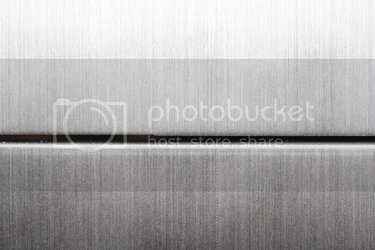
Here is the side panel of the ATC-201.
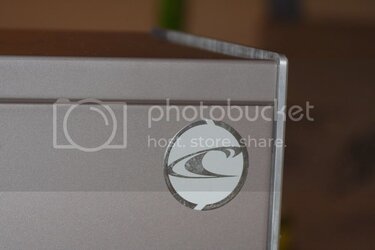
Here is the Lian Li. The corner piece is plastic held on by the screws. The flash helps it look somewhat the same, but in person the difference in material is more noticeable. One thing to point out is unlike the Cooler Master cases which have a side and a top, the Lian Li has a side, middle, and top so there are two seams instead of one. One complaint I have about this case is the lower seam is not uniform from front to back of the case, they should have either rolled the edge under the whole way or left it strait the whole way, the transition draws attention to it at which point you notice the gap between the side panel and the middle strip. The gap isn’t really a manufacturing tolerance problem but rather a design issue, because the middle strip isn’t rolled under all the way to the front of the case, the side panel can’t get any higher up. The silver shining through toward the front of the case can’t really be seen in normal lighting without the camera flash.
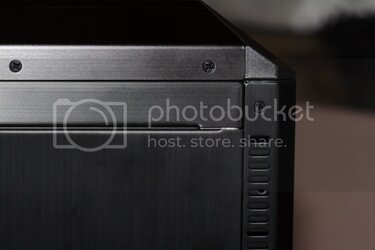
ATCS 840 side panel top corner. The silver shining through toward the front of the case can’t really be seen in normal lighting without the camera flash.
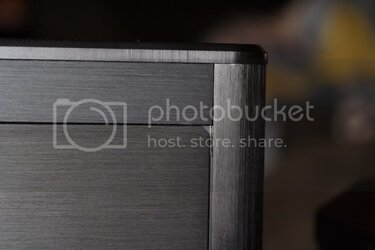
A final nitpick about the Lian Li: they should have done a better job with the top of the case. It feels unfinished with the plastic end cap screwed on the front and the back being aluminum sloppily bent into shape and not even attached together.
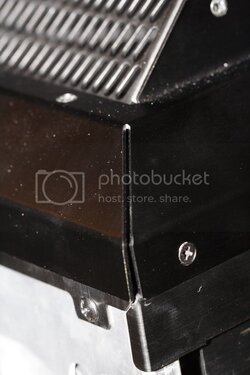
Miscellaneous
The screws used by Cooler Master haven’t changed a bit in the past 8 years. The left two screws are the ATC-201 and ATCS 840, the right is Lian Li. It feels like the Cooler Master screws are a heavier material, maybe just because they are larger. The larger diameter and longer grooved surface makes them easier to grip.
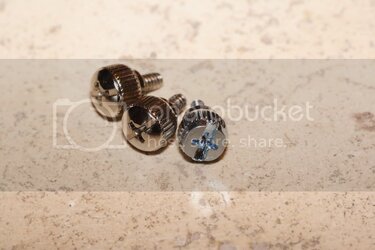
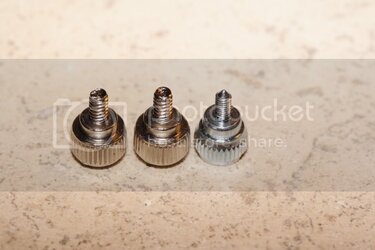
The design of the ATC-201 allows you to remove the motherboard tray without removing either side. The ATCS 840 not shown here, covers the motherboard tray with the back of the side panels. Obviously you will usually be removing the “normal” side, but it shouldn’t be necessary to remove the side behind the motherboard tray unless you want to. The Lian Li does not have a removable motherboard tray.
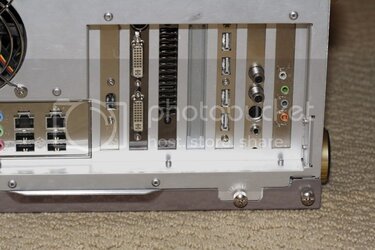
Conclusions
Neither of the cases I was looking at to replace the ATC-201 come close to matching its sturdy construction. The ATCS 840 has a solid construction for the front and top of the case. There is nothing wrong with the rest of the ATCS; I just wouldn’t be comfortable jumping up and down on it like I would be with the ATC-201. The Lian Li on the other hand just didn’t meet my expectations. I guess I’m glad I had the Lian Li to compare the ATCS against, otherwise I wouldn’t have a benchmark for how thin materials can be.
They just don’t seem to make cases like they used to. Maybe my sample size of 3 cases isn’t big enough to really draw any conclusions, but the fact that it doesn’t seem like many review sites (at least that I could find) complain about thinness of material was somewhat surprising. I wouldn’t mind if reviews started including that kind of information on top of just talking about sound, airflow, and how well components fit. I mean those are all important, but so are quality of materials and build quality. On that note, it is important to point out that the ATCS and Lian Li have a lot of merits which can be read about elsewhere, I just chose to focus my attention on the build and materials.
This post might read like I am biased against the Lian Li. I might agree with that assessment, it is my least favorite of the three cases. But remember that I did not start out with this bias. I originally bought the case based on my impressions of Lian Li’s reputation and after a lot of consideration. I was really looking forward to the Lian Li, but once I got it in my hands the quality disappointed. I wanted to like the Lian Li, I really did. I even kicked around the idea of keeping it after I found out how expensive it would be to return, but couldn’t bring myself to do it. Despite a somewhat biased tone, hopefully if you are considering the Lian Li PC-B25S or Cooler Master ATCS 840 the pictures and descriptions of materials will be useful to you in conjunction with other typical reviews you’ll find of these cases.
Last edited: